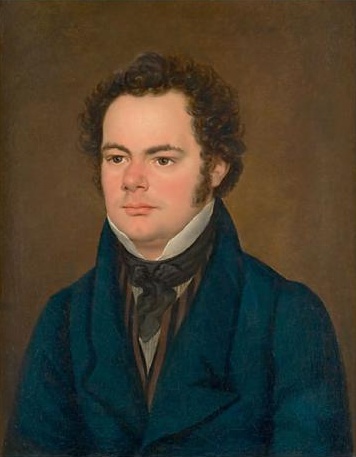Franz Schubert
(1797~1828)
String Quintet in C Major, D. 956
Franz Schubert's final chamber work, the String Quintet in C major (D. 956, Op. posth. 163) is sometimes called the "Cello Quintet" because it is scored for a standard string quartet plus an extra cello instead of the extra viola which is more usual in conventional string quintets. It was composed in 1828 and completed just two months before the composer's death.
The first public performance of the piece did not occur until 1850, and publication occurred three years later in 1853. Schubert's only full-fledged string quintet, it has been praised as "sublime" and as possessing "bottomless pathos," and is generally regarded as Schubert's finest chamber work as well as one of the greatest compositions in all chamber music.
The string quintet was composed in summer or early fall of 1828, at the same time as Schubert
composed his last three piano sonatas and several of the Schwanengesang songs.
Schubert completed it in late September or early October, just two months before his death.
Schubert submitted it to one of his publishers, Heinrich Albert Probst, for consideration, saying that "finally I have written a quintet for 2 violins, 1 viola, and 2 violoncello ... the quintet rehearsal will only begin in the next few days. Should any of these compositions by any chance commend themselves to you, please let me know."
Probst replied, asking only to see some of Schubert's vocal works and requesting more popular piano music. Even at this very late stage in Schubert's career, it is obvious that he was regarded as a composer who mainly focused on songs and piano pieces, and was definitely not taken seriously as a chamber music composer.
The work remained unpublished at the time of Schubert's death in November 1828, and indeed waited twenty-five years for its first publication in 1853. Its first known public performance occurred only three years earlier, on 17 November 1850 at the Musikverein in Vienna.
Budapest / Heifetz 1941
Instrumentation and genre
A string quintet is a composition written for string quartet (two violins, viola, and cello) augmented by a fifth string instrument, usually a second viola. Schubert's string quintet is scored for two violins, one viola, and two cellos—that is, a string quartet plus a second cello.
The work is the only full-fledged string quintet in Schubert's oeuvre. When he began composing his string quintet, Schubert had already composed an impressive body of chamber music for strings,
including at least fifteen string quartets, most of which were composed for domestic performance by his family's string quartet.
In selecting the key of C major for his only string quintet, Schubert may have been gesturing to two composers he greatly admired, Mozart and Beethoven, both of whom wrote string quintets in that key, Mozart's String Quintet No. 3 in C major, K. 515 and Beethoven's String Quintet, Op. 29 in C major. According to Charles Rosen, the opening theme of Schubert's work emulates many characteristics of the Mozart quintet's opening theme, such as decorative turns, irregular phrase lengths, and rising staccato arpeggios (the latter appear only in Schubert's recapitulation).[7]
But whereas the string quintets of Mozart and Beethoven are composed for a string quartet augmented by a second viola, Schubert adopts a somewhat unconventional instrumentation, employing two cellos instead of two violas, creating richness in the lower register. Before Schubert, Luigi Boccherini had replaced the second viola with a second cello; however, Schubert's use of the second cello
is very different from Boccherini's, who uses the additional cello to create an additional viola line.
The string quintet consists of four movements in the usual quick-slow-scherzo-quick pattern:
- Allegro ma non troppo
슈베르트 현악 5중주의 1악장이 시작되면 평이한 C장조 화음이 들려오지만 이내 감7화음의 불안정한 화음이 그 뒤를 따르며 불안정한 분위기를 만들어낸다. 1악장 내내 편안한 장조 화음과 비틀린 단조 화음의 교대가 계속되며 묘한 불안감을 자아내는데, 이는 슈베르트 말년의 작품에 자주 나타나는 특성으로 신비롭고 영적인 느낌을 전해준다. 1악장 제시부에서 두 대의 첼로로 연주되는 제2주제는 이 작품에서 매우 유명한 선율로 이 작품에 따스하고 포근한 빛을 부여하는 아름다운 음악이다.
- Adagio
느린 2악장은 매우 영감에 찬 음악으로, 뚜렷한 선율선이 드러나기보다는 연속하는 화음이 하나의 선율적인 흐름을 만들어내며 주제를 이룬다. 이는 비슷한 시기에 작곡된 슈베르트의 피아노 소나타 D.960의 2악장과 매우 유사한 방식으로, 화음적인 선율이 여러 가지 장식적인 음형에 의해 변주되는데, 그 과정에서 제2첼로가 손가락으로 현을 퉁겨 소리를 내는 피치카토 주법이 매우 효과적으로 사용되었다. 2악장 중간 부분에서 슈베르트는 아무런 예고도 없이 갑작스럽게 슬픔과 격정을 폭발시킨 후 극도의 여린 음으로 마무리하며 극에서 극으로 치닫는 감정의 기복을 생생하게 담아냈다.
- Scherzo. Presto – Trio. Andante sostenuto
3악장은 시골 풍 춤곡의 활력이 느껴지는 음악이지만, 중간 트리오 부분에서 템포가 느려지면서 또다시 우울한 분위기에 휩싸인다. 이 작품의 트리오는 슈베르트의 전 작품들 중 강한 대조의 원리를 보여주는 음악으로 활력에 넘치는 스케르초와 강한 대비를 이룬다
4. Allegretto
4악장은 헝가리 풍의 이국적인 주제로 시작하는 음악이다. 마지막 부분에서 두 번에 걸쳐 매우 빠른 템포로 격앙되면서
화려하고 압도적인 결말을 이끌어낸다
Isaac Stern: violin /Alexander Schneider: violin
Milton Katims: alto / Pablo Casals:cello / Paul Tortelier: cello-Prades-1952===
'♣ 음악 감상실 ♣ > [Schubert]' 카테고리의 다른 글
| [Chamber music by Franz Schubert"] (0) | 2015.05.24 |
|---|---|
| Schubert - Violin Sonata in A major, D 574 (0) | 2015.05.09 |
| 슈베르트(Schubert) - Piano Sonata 모음 (0) | 2015.01.27 |
| [오스트리아]프란츠 슈베르트[Franz Peter Schubert] (0) | 2014.11.26 |
| 슈베르트(Schubert )-바이올린 소나타 4번 (0) | 2014.11.26 |
